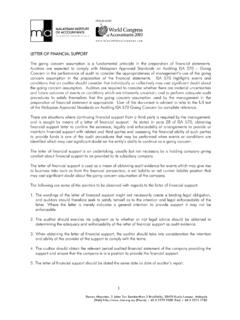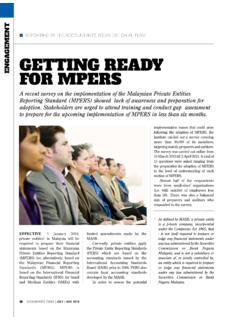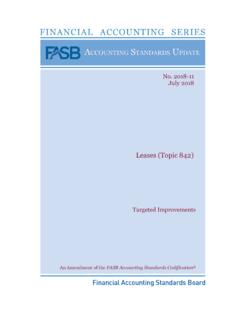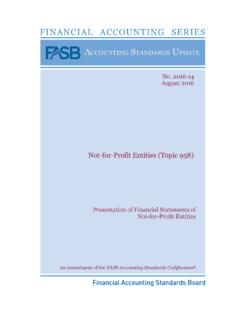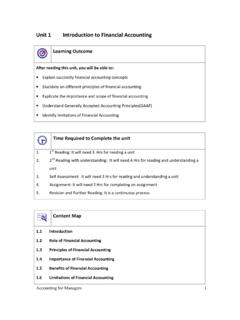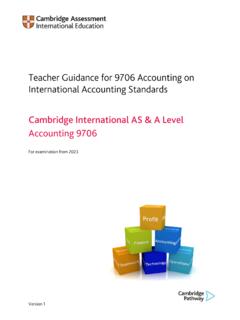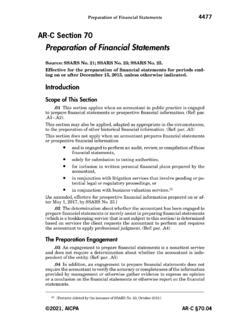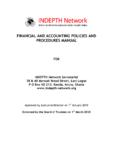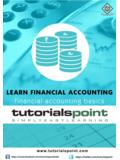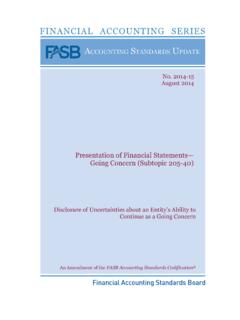Transcription of ADVANCED FINANCIAL ACCOUNTING AND REPORTING
1 1 MIA QUALIFYING EXAMINATION STUDY GUIDE ADVANCED FINANCIAL ACCOUNTING AND REPORTING NO CONTENT REFERENCE LEVEL OF KNOWLEDGE FINANCIAL ACCOUNTING and REPORTING in Malaysia B Discuss the development of FINANCIAL ACCOUNTING and REPORTING in Malaysia Discuss the role of regulators such as MASB, Securities Commission, Bursa Malaysia, Bank Negara etc. in regards to FINANCIAL REPORTING in Malaysia Discuss the future direction of FINANCIAL REPORTING in Malaysia and internationally including the emergence and development of Islamic ACCOUNTING Discuss the rationale for moving towards fair value ACCOUNTING - FINANCIAL REPORTING Act 1997 - ACCOUNTING standards , Exposure Drafts issued by MASB and IASB - Companies Act 2016 - Guidelines of the Securities Commission - Bursa Malaysia Listing Requirements - Bank Negara Malaysia Guidelines (GP3, GP 8 and GPI 15) Preparation and presentation of FINANCIAL statements of companies Framework for the preparation and presentation of FINANCIAL statements in Malaysia A Discuss what is meant by conceptual framework for FINANCIAL REPORTING Conceptual Framework 2 Describe the objectives of FINANCIAL statements and the qualitative characteristics of FINANCIAL information Identify the users of FINANCIAL statements and their information needs to make economic decisions Discuss the criteria for the recognition of the elements of FINANCIAL statements Explain the different measurement bases of the elements of FINANCIAL statements Discuss the importance of fair value ACCOUNTING in the present environment of FINANCIAL ACCOUNTING and REPORTING in Malaysia Discuss the measurement of income and capital maintenance under historical cost ACCOUNTING and alternative approaches Discuss the importance of recognising.
2 Measuring and REPORTING transactions and events in accordance to the substance and not just the legal form for the Preparation and Presentation of FINANCIAL Statements - ACCOUNTING standards , Exposure Drafts issued by MASB and IASB Preparation and presentation of FINANCIAL statements for public companies A Prepare the FINANCIAL statements in accordance with FINANCIAL REPORTING standards and Malaysian Companies Act 1965 o Statement of FINANCIAL Position o Statement of Comprehensive income o Statement of Changes in Equity o Statement of Cash Flow o Notes to the FINANCIAL statements including the disclosure on ACCOUNTING policies adopted by companies o Disclosure of operating results, assets and liabilities of discontinued operations o Computation of basic earnings per share and diluted earnings per share MFRS 101, MFRS 107, & MFRS 134 3 Prepare interim FINANCIAL report and explain the requirements of MFRS 134 o Explain the content of interim FINANCIAL statements o Explain the presentation of interim FINANCIAL statements o Explain the recognition and measurement of items in interim FINANCIAL statements o Explain the ACCOUNTING treatment if there is a change in ACCOUNTING policy Application of FINANCIAL REPORTING standards on the preparation of FINANCIAL statements A ACCOUNTING for assets Property, plant and equipment o Discuss the recognition criteria of property, plant and equipment o Determine the initial measurement of property, plant and equipment o Explain the ACCOUNTING treatment of subsequent expenditure o Explain the subsequent measurement of property.
3 Plant and equipment Cost model Revaluation model Explain the ACCOUNTING treatment when revaluation model is adopted by company Explain the treatment of revaluation surplus / deficit on the initial revaluation and subsequent revaluation Explain the treatment of revaluation surplus when the property, plant and MFRS 116 MFRS 141 4 equipment are disposed of o Account for depreciation Calculate depreciation on assets purchased or self-constructed using different methods Calculate depreciation on assets subsequent to the incurrence of subsequent expenditures that are capitalised Calculate depreciation on assets subsequent to revaluation o Explain the disclosure requirements of MFRS 116 on property, plant and equipment o Explain the effects of amendments on MFRS 141 on PPE (Agriculture: Bearer Plants) (amendments to MFRS 116 and MFRS 141) o Explain effects of Clarification of Acceptable Methods of Depreciation and Amortisation (amendments to MFRS 116 and MFRS 138)
4 Borrowing costs o Define borrowing costs o Discuss the examples of borrowing costs according to MFRS 123 o Define qualifying asset o Discuss the treatment for borrowing costs o Discuss the arguments for and against capitalising borrowing costs o Explain the rules relating to commencement, suspension and cessation of capitalisation of borrowing costs on qualifying asset MFRS 123 5 o Explain the disclosure requirements of MFRS 123 on the treatment of borrowing costs Impairment of assets o Define impairments o Explain the underlying principle in testing and measuring impairment loss o Discuss the indications that an asset may be impaired o Apply the appropriate ACCOUNTING treatment on an individual asset that is impaired including the determination of the recoverable amount Explain the value in use and the asset s fair value less costs to sell o Apply the appropriate ACCOUNTING treatment on cash-generating unit that is impaired recoverable amount Apply the procedures to be followed when allocating impairment loss between the assets in the cash-generating unit o Explain the measurement of corporate assets that are impaired o Explain and calculate reversal of an impairment loss for an individual asset o Explain
5 And calculate reversal of an impairment loss for a cash-generating unit o Explain the disclosure requirements of MFRS 136 pertaining the impairment of assets ACCOUNTING for investment property o Define investment property MFRS 136 6 o Explain the recognition criteria and initial measurement of investment property o Discuss the subsequent measurement of investment property Fair value model Cost model o Discuss the measurement of investment property when there are transfers Transfer from investment property to owner-occupied property Transfer from investment property to inventories Transfer from owner-occupied property to investment property Transfer from inventories to investment property Transfer from property in the course of construction of development (MFRS 116) to investment property o Transfer a property to or from investment property when there is evidence of change of use o Explain the disclosure requirements of MFRS 140 on investment property ACCOUNTING for government grants and disclosure of government assistance o Define government grants o Explain the recognition criteria of government grants o Discuss the possible treatments/ approaches of ACCOUNTING of government grants Capital approach Income approach MFRS 140 MFRS 120 7 o Discuss the presentation of grants related to assets in the FINANCIAL statements Treat as deferred income Deducting the grant from the asset s carrying amount o Explain the ACCOUNTING treatments of governments grants that are revoked or becomes repayable o Define government assistance o Explain the disclosure requirements of MFRS 120 on government grants and government assistance Non-current assets held for sale and presentation of discontinued
6 Operations o Explain non-current asset held for sale and disposal group o Explain the recognition criteria for non-current asset or disposal group o Explain and apply the appropriate measurement requirements of non-current asset or disposal group classified as held for sale At time of classification as held for sale After classification as held for sale Impairment Explain the recognition of impairment losses and reversals of impairment losses when the measurement of non-current asset or disposal group classified as held for sale take place Assets carried at fair value prior to initial classification MFRS 5 8 Subsequent increases in fair value o Discuss the cessation of the classification of non-current asset or disposal group held for sale Explain the measurement of the non-current asset or disposal group that are no longer classified as held for sale o Explain the disclosure requirements of MFRS 5 ACCOUNTING for assets acquired through leases o Discuss the substance over form principle in relation to leases o Distinguish between a finance lease and an operating lease o Explain the ACCOUNTING treatment of a finance lease in the books of the lessor and the lessee o Explain the ACCOUNTING treatment of an operating lease in the books of the lessor and the lessee o Explain the methods of allocating finance charges Actuarial method Sum-of-digits method o Explain the ACCOUNTING treatment in the books of a manufacturer of property.
7 Plant and equipment who is also a lessor or dealer o Discuss the rationale of a sale and leaseback transaction o Explain the ACCOUNTING treatment of a sale and leaseback transaction in the books of lessor and lessee MFRS 117 9 If the sale and leaseback falls under operating lease If the sale and leaseback falls under finance lease o Explain the disclosure requirements of MFRS 117 on leases in the books of lessor and lessee for both finance lease and operating lease Leases (effective for annual period beginning or after 1 January 2019) o Explain the scope and recognition exemptions o Explain and apply the requirements in identifying a lease and separating components of a contract o Apply MFRS 16 requirements in respect of ACCOUNTING by lessees o Apply MFRS 16 requirements in respect of ACCOUNTING by lessors o Explain and apply the treatments for sale and leaseback transactions o Explain the disclosure requirements of MFRS 16 ACCOUNTING for intangible assets o Define intangible assets o Discuss the recognition criteria, initial and subsequent measurement of intangible assets o Explain the ACCOUNTING treatment of research and development costs o Explain the ACCOUNTING treatment of development costs that are impaired o Explain the disclosure requirements of MFRS 138 on intangible assets MFRS 16 MFRS 138 10 o Explain effects of Clarification of Acceptable Methods of Depreciation and Amortisation (amendments to MFRS 116 and MFRS 138)
8 ACCOUNTING for inventories MFRS 102 Explain the measurement of inventories in accordance with MFRS 102 o Explain how the cost of inventories is arrived at Cost of purchase Cost of conversion Other costs Cost formulas used to assign the cost of inventories Costs not included o Explain how net realisable value is determined o Explain how the writing down of inventories to the net realisable value is made Explain the circumstances under which the cost of inventories is recognised as expenses Explain the measurement rule of raw materials at the balance sheet date Explain the disclosure requirements of MFRS 102 on inventories ACCOUNTING for FINANCIAL instruments Disclosure and presentation o Define FINANCIAL assets, FINANCIAL liability and equity instrument o Discuss the classification of FINANCIAL instruments into FINANCIAL assets, FINANCIAL liability and equity instrument o Measurement of compound FINANCIAL instruments and subsequent ACCOUNTING treatment MFRS 7, MFRS 132, 11 o Explain the ACCOUNTING treatment of treasury shares when they are purchased, sold, issued or cancelled o Discuss the ACCOUNTING treatment of interest, dividends.
9 Losses and gains relating to FINANCIAL instruments o Discuss the circumstances under which offsetting of FINANCIAL asset and a FINANCIAL liability is allowed o Explain the disclosure requirements of MFRS 132 on FINANCIAL instruments Recognition and measurement o Explain derivatives o Explain the different categories of FINANCIAL instruments o Explain the recognition of FINANCIAL asset and FINANCIAL liability Trade date method Settlement date method o Explain the initial measurement of FINANCIAL asset and FINANCIAL liability o Explain the ACCOUNTING treatment of transaction costs o Explain the subsequent measurement of FINANCIAL asset and FINANCIAL liability o Explain the ACCOUNTING treatment of FINANCIAL instruments that are reclassified o Explain the ACCOUNTING treatment of change in fair value of FINANCIAL instruments o Discuss the evidence that FINANCIAL asset or group of FINANCIAL asset is impaired o Explain the ACCOUNTING treatment of impairment of FINANCIAL assets under various classifications MFRS 139 12 o Discuss the derecognition of a FINANCIAL asset and a FINANCIAL liability MFRS 9 FINANCIAL Instruments Explain and apply the requirements as per MFRS 9 o Explain the initial measurement of FINANCIAL instruments o Account for the subsequent measurement of FINANCIAL assets Debt instruments business model test and cash flow characteristics test Fair value option Equity instruments Other comprehensive income option o Account for subsequent measurement of FINANCIAL liabilities Fair value option Trade date method Settlement date method o Apply and account for derecognition of FINANCIAL assets o Apply and account for derecognition of FINANCIAL liabilities o Apply and account for derivatives and embedded derivatives o Perform reclassification in accordance with MFRS 9 o Apply hedge ACCOUNTING Fair value hedge Cash flow hedge Hedge of a net investment in a foreign operation o Apply and account for impairment as per
10 MFRS 9 MFRS 9 13 Explain the presentation and disclosure requirements of MFRS 9 on FINANCIAL instruments ACCOUNTING for employee benefits MFRS 119 A Discuss the different categories of employee benefits o Short-term employee benefits o Post-employment benefits Defined contribution plan Explain the ACCOUNTING treatment of defined contribution plan Defined benefit plan Explain and apply the appropriate ACCOUNTING treatment of defined contribution plan, including requirements for measurement and past service costs Unit credit method Account for actuarial gains and losses o Other long-term employee benefits o Termination benefits Explain the disclosure requirements of MFRS 119 and MFRS 126 on ACCOUNTING for retirement benefits ACCOUNTING for income taxes MFRS 112 A Explain what is meant by tax base, deferred tax, taxable and deductible temporary differences Discuss the full provision method in determining the deferred tax Account for deferred tax o Calculate the taxable temporary difference and deductible temporary difference o Deferred tax liability and deferred tax asset Explain the measurement of
